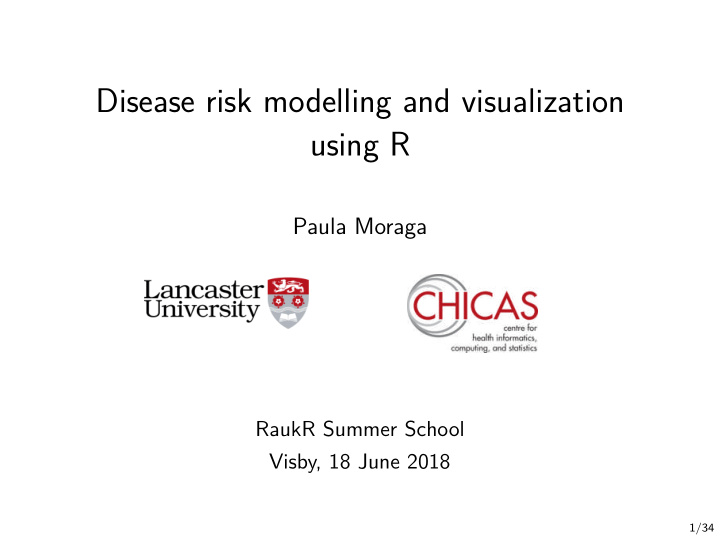



Disease risk modelling and visualization using R Paula Moraga RaukR Summer School Visby, 18 June 2018 1/34
Outline Introduction to disease mapping Tutorials Tutorial: areal data Tutorial: geostatistical data Presentations options: interactive dashboards and Shiny apps SpatialEpiApp 2/34
Introduction to disease mapping 3/34
John Snow’s map of cholera deaths in Soho, London, 1854 4/34
Disease mapping Disease maps help understand the spatial patterns of disease and its determinants. This information can guide decision makers and programme managers to better allocate limited resources and to design strategies for disease prevention and control 5/34
Types of spatial data 1. Areal data 2. Geostatistical data 3. Point patterns Moraga and Lawson 2012 Moraga et al. 2015 Moraga and Montes 2011 6/34
Modelling • Disease risk predictions are based on the observed disease cases, the number of individuals at risk, and risk factors information such as demographic and environmental factors • Models describe the variability in the response variable as a function of the risk factors covariates and random effects to account for unexplained variability 7/34
Areal data Moraga and Lawson 2012 8/34
Areal data Disease risk is often estimated by the Standardized Mortality Ratio: SMR = Y E • Y number of observed cases • E number of expected cases if the study population had the same disease rate as the standard population • SMR > 1 : more cases observed than expected • Expected cases calculated using indirect standardization m r ( s ) � E = j n j j =1 • r ( s ) = (number of events)/(number of individuals at risk). Rate j in strata j (e.g. age group, sex) in the standard population • n j population in stratum j of the observed population 9/34
Areal data • SMRs may be misleading and insufficiently reliable in areas with small populations • In contrast, model-based approaches enable to incorporate covariates and borrow information from neighboring areas to improve local estimates, resulting in the smoothing of extreme rates based on small sample sizes 10/34
Areal data Model to estimate disease risks θ i in areas i = 1 , . . . , n Y i | θ i ∼ Po ( E i × θ i ) , log( θ i ) = z ′ i β + u i + v i • u i is an structured spatial effect to account for the spatial dependence between relative risks (areas that are close show more similar risk than areas that are not close) • v i is an unstructured spatial effect to account for independent area-specific noise 11/34
Geostatistical data Moraga et al. 2015 12/34
Geostatistical data Y i | P ( x i ) ∼ Binomial ( N i , P ( x i )) , logit ( P ( x i )) = z ′ i β + S ( x i ) + v i Risk factors covariates Gaussian Random Field (e.g. temperature, precipitation, vegetation, etc) NASA Earth Observations 13/34
Coordinate Reference Systems (CRS) 1 unprojected or geographic : Latitude/Longitude for referencing location on the ellipsoid Earth 2 projected : Easting/Northing for referencing location on 2-dimensional representation of Earth. Common projection: Universal Transverse Mercator (UTM) 14/34
Tutorials 15/34
Install R packages install.packages ( c ("dplyr", "ggplot2", "leaflet", "geoR", "rgdal", "raster", "sp", "spdep", "SpatialEpi", "SpatialEpiApp")) install.packages ("INLA", repos = "https://inla.r-inla-download.org/R/stable", dep = TRUE) 16/34
Tutorial: areal data 17/34
Areal data. Lung cancer in Pennsylvania https://paula-moraga.github.io/tutorial-areal-data/ 18/34
Tutorial: geostatistical data 19/34
Geostatistical data. Malaria in The Gambia https://paula-moraga.github.io/tutorial-geostatistical-data/ 20/34
Presentations options: interactive dashboards and Shiny apps 21/34
Interactive dashboards with flexdashboard • https://rmarkdown.rstudio.com/flexdashboard/ • Uses R Markdown to publish a group of related data visualizations as a dashboard • Components that can be included include plots, tables, value boxes and htmlwidgets 22/34
Layout 23/34
Example https://rmarkdown.rstudio.com/flexdashboard/examples.html 24/34
Interactive Shiny web applications • https://shiny.rstudio.com/ • Shiny is a web application framework for R that enables to build interactive web applications 25/34
SpatialEpiApp 26/34
R package SpatialEpiApp • Shiny web application that allows to visualize spatial and spatio-temporal disease data, estimate disease risk and detect clusters • Risk estimates by fitting Bayesian models with INLA • Detection of clusters by using the scan statistics in SaTScan Launch SpatialEpiApp: install.packages ("SpatialEpiApp") library (SpatialEpiApp) run_app () 27/34
Data entry 28/34
Interactive 29/34
Maps 30/34
Clusters 31/34
Report 32/34
References • Paula Moraga. SpatialEpiApp: A Shiny Web Application for the analysis of Spatial and Spatio-Temporal Disease Data, (2017), Spatial and Spatio-temporal Epidemiology, 23:47-57 • Winston Chang, Joe Cheng, JJ Allaire, Yihui Xie and Jonathan McPherson (2017). shiny: Web Application Framework for R. https://CRAN.R-project.org/package=shiny • Barbara Borges and JJ Allaire (2017). flexdashboard: R Markdown Format for Flexible Dashboards. https://CRAN.R-project.org/package=flexdashboard 33/34
Thanks! https://Paula-Moraga.github.io Twitter @_PaulaMoraga_ 34/34
Recommend
More recommend